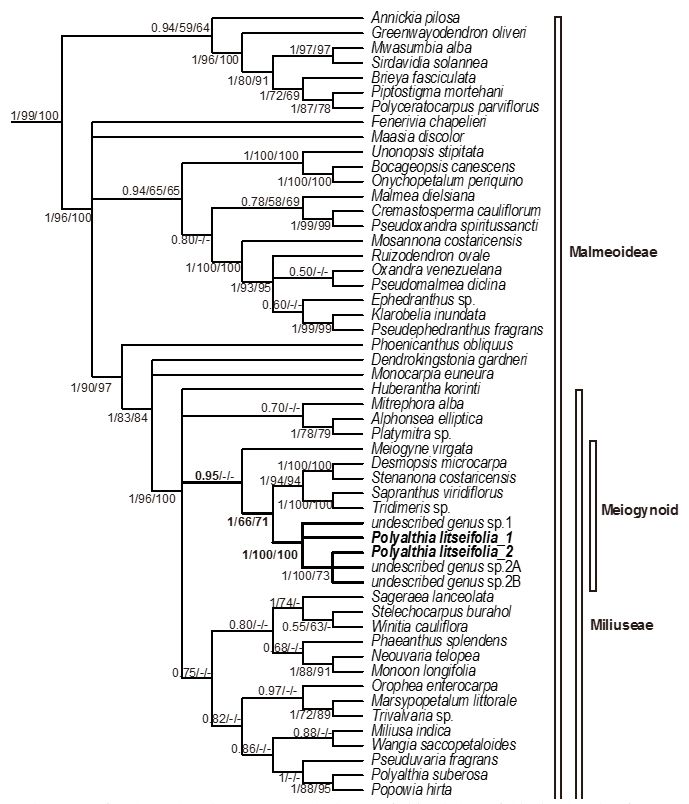The cherimoya family (Annonaceae) is a species-rich family of pantropical angiosperms with about 2,500 species of trees, shrubs and vines that are important components of lowland rainforest ecosystems. Although a large number of studies have been carried out on the taxonomics of this family in many aspects such as classical taxonomy and molecular systematics, there are still many taxonomic problems in this family that need to be clarified.
Polyalthia Blume is the largest genus of tribe Miliuseae in the Family Annonaceae, mainly distributed in tropical Asia. Professor Li Bingtao published a new species of the genus in 1976 based on a specimen collected in the jinghong valley forest in Yunnan (collected in 1957) and named it the Wood Ginger Leaf Dark Luo Polyalthia litseifolia C.Y.Wu ex P.T.Li according to Mr. Wu Zhengyi's proposal. This species is a large deciduous tree, which can reach a height of 40 meters; the leaves begin to fall in December every year, and the new leaves grow at the same time as the flowers in March and April of the following year. Since its publication, the species has been considered an endemic species of the Chinese genus Cryptosystem. However, due to the small number of specimens and the short flowering period making it difficult to collect flower specimens, there are still doubts about the systematic location of this species, such as the species was once thought to be related to M. Monoon Miquel. thorelii (Pirre) B.Xue & R.M.K. Saunders proximate.
In recent years, with the continuous deepening of field investigations, researchers have collected more specimens of wood ginger leaf dark luo in Mengla, Lincang, Jinghong, Jiangcheng and other areas in Yunnan, which has enriched the geographical distribution information of this species. Based on the obtained materials, the researchers conducted more detailed morphological studies of the species and obtained molecular data for phylogenetic reconstruction. The results showed that the species was not closely related to the genus Murphyllum and the genus Eucalyptus, but was sisterly with the only Mesoamerican branch of the wild solitary family (mainly in Asia) (Figure 1). Based on a variety of comprehensive evidence, the independent systematic position of the wild solitary family of Wood Ginger Leaf Dark Luo has been well supported, and molecular results and morphological comparisons support it as a new genus of this family, and officially named it Wuodendron B.Xue, Y.H.Tan & T. Chaowasku, in honor of Mr. Wu Zhengyi, who has made significant contributions to botanical research. The main features of this new genus are: deciduous trees with enlarged petiole base enveloping the understep buds; flowers solitary, growing from leaf marks shedding from old leaves; two rounds of petals, nearly equal length of inner and outer wheels; ovules 3–5(–8); endosperm flaks, etc. (Figure 2).
Divergence time estimation results indicate that the divergence between the genus rhizophoeae and its sister group branches occurred in the Miocene 14–12 Ma, providing a new example of the formation of intermittent distribution patterns of plant taxa between tropical continents due to the spread and isolation of northern forests. In addition, extensive specimen review and fieldwork have found that the distribution of the new genus is not limited to China, but is widely distributed in the Indo-Burma biodiversity hotspot. However, despite its wide range, a sharp decline in the number of individual populations has been observed in all regions, especially in the 1980s and 1990s when it was heavily deforested, and its survival and reproduction are seriously threatened by the destruction of tropical rainforest habitats. It is assessed as endangered according to the IUCN Red Book of Endangered Species criteria.
The research was done by Dr. Xue Bin'e, Ph.D. of the South China Botanical Garden of the Chinese Academy of Sciences, Tan Yunhong, Associate Researcher of xishuangbanna Tropical Botanical Garden, Daniel Thomas, Ph.D. of Singapore Botanical Garden, Tanawat Chaowsaku of Chiang Mai University in Thailand, Professor Hou Xueliang of Xiamen University, and Richard Saunders, Professor of the University of Hong Kong. The research was supported by the National Natural Science Foundation of China, the Southeast Asian Biodiversity Research Center of the Chinese Academy of Sciences, the Thailand Research Project and the Chiang Mai University Startup Project. The research paper has recently been published in the international taxonomy journal Taxon.

Figure 1 The phylogenetic relationship based on the seven chloroplast fragments and the Bayesian method shows the systematic position of Polyalthia litseifolia
Fig. 2 Morphological characteristics of the genus Yttrium